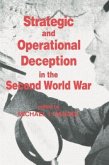Second World War history offers the military strategist a cornucopia of lessons learned on how to apply the art of military deception. This paper analyzed six Allied deception operations to identify the fundamental reasons why Allied deception efforts were the most successful in history. The six deception operations reviewed were Barclay, Cockade, and Bodyguard as well as the Soviet deception operations at Stalingrad, Kursk, and White Russia. A critical analysis of these six operations identified seven major factors that made Allied deception efforts extremely effective. These seven factors were that the Allies controlled all key channels of information, had great intelligence "feedback" on their deception operations, had high-level and centralized control over deception planning, practiced sound deception techniques, subordinated deception to strategic and operational objectives, maintained adequate secrecy, and provided sufficient time for deception execution. These factors are relevant for today's operations and should be imbedded within US doctrine.
Hinweis: Dieser Artikel kann nur an eine deutsche Lieferadresse ausgeliefert werden.
Hinweis: Dieser Artikel kann nur an eine deutsche Lieferadresse ausgeliefert werden.








